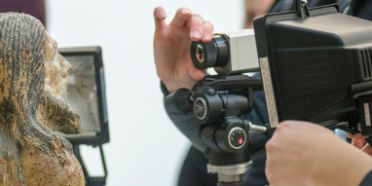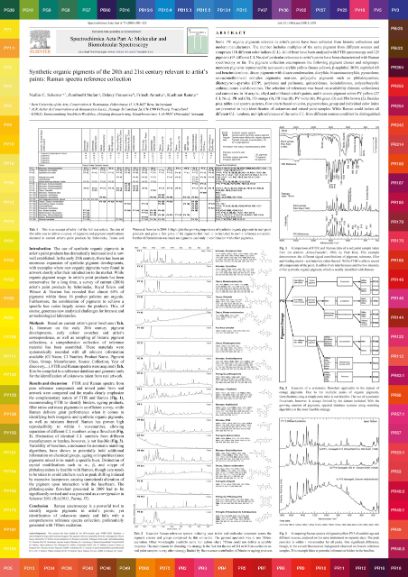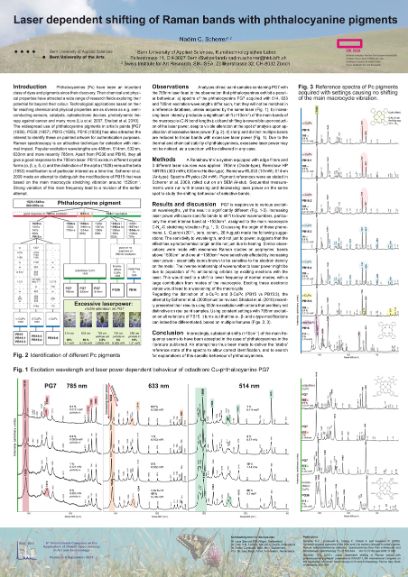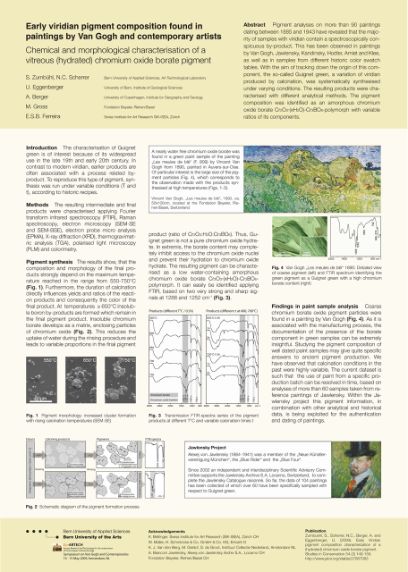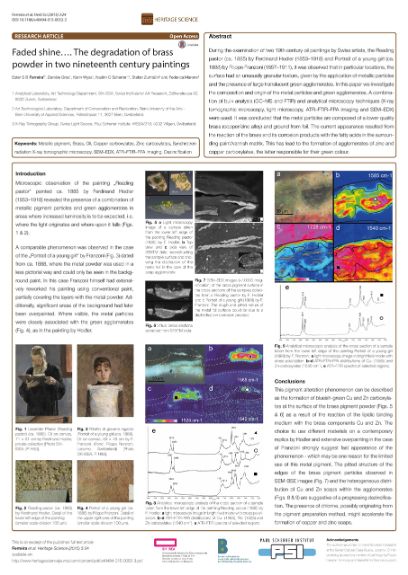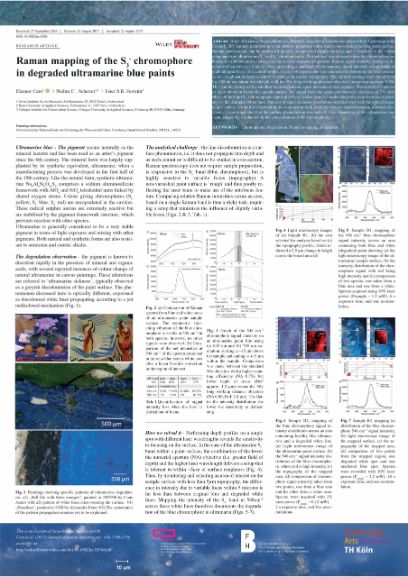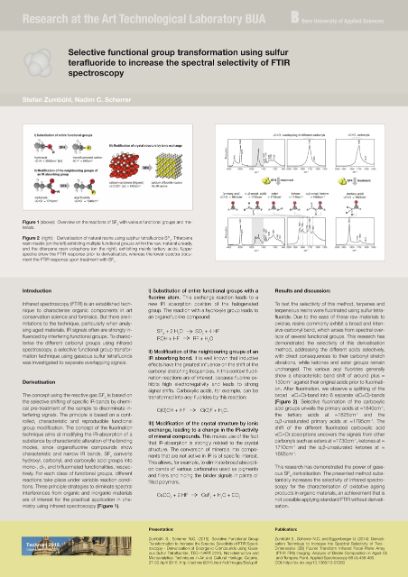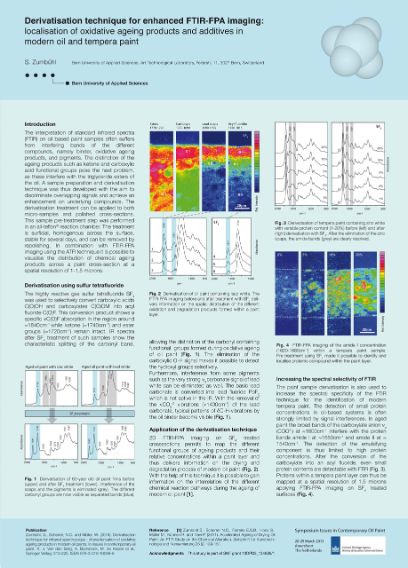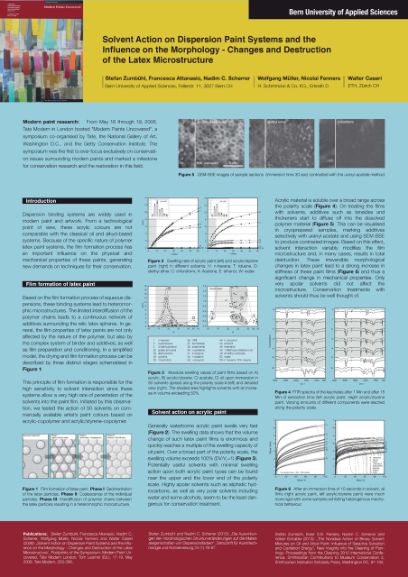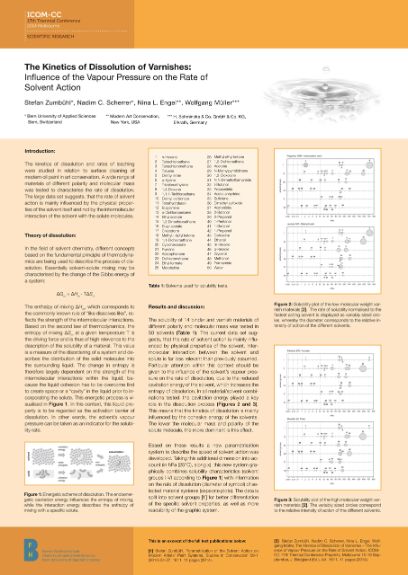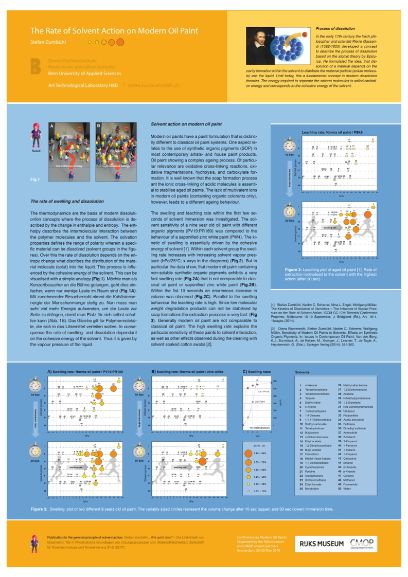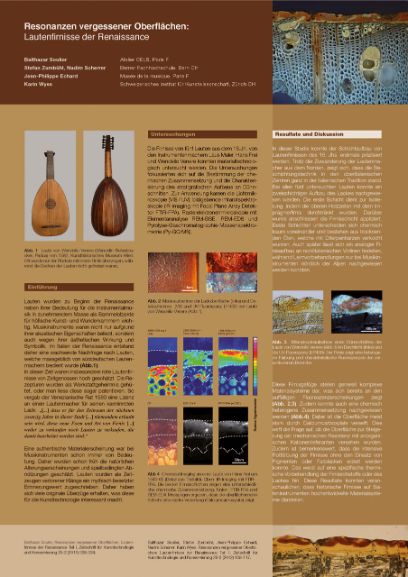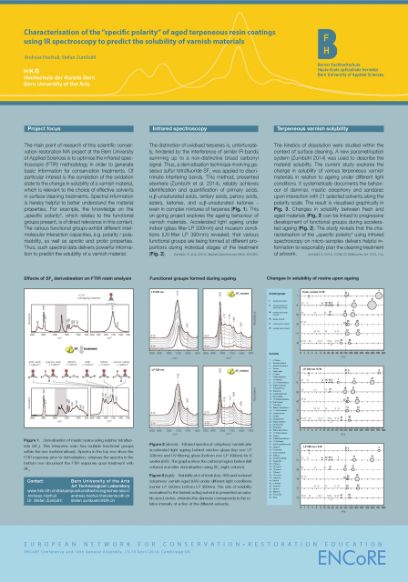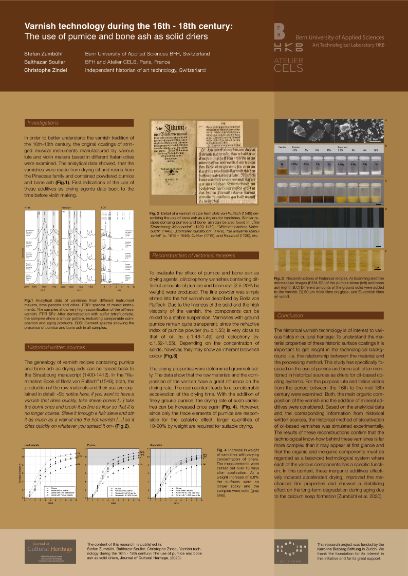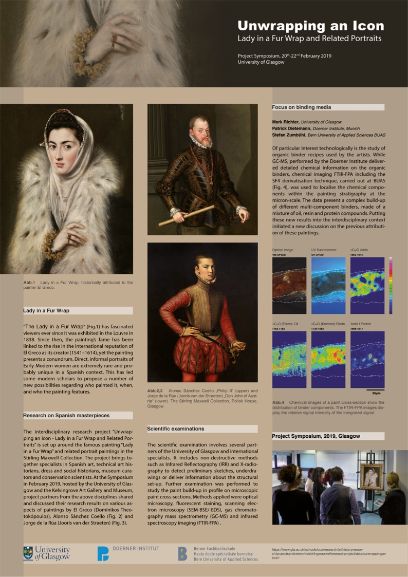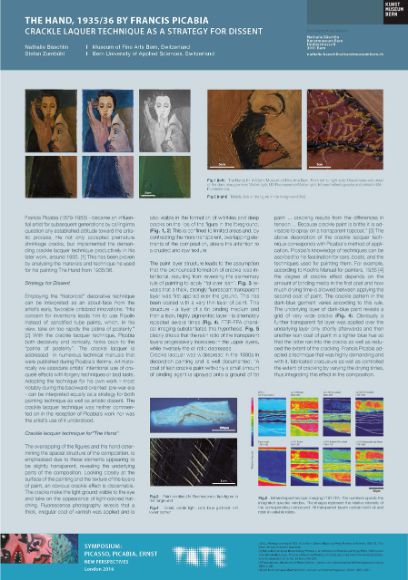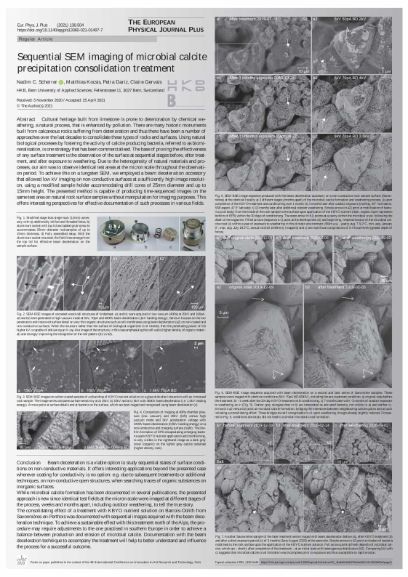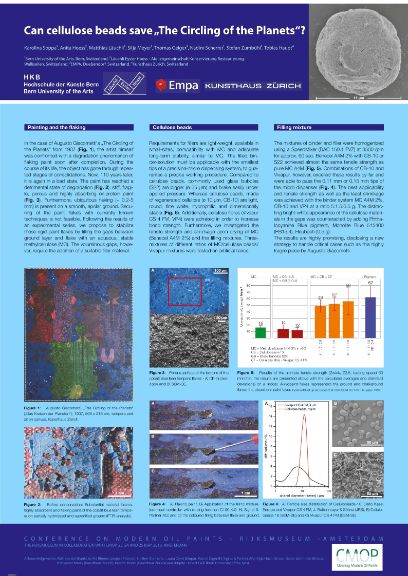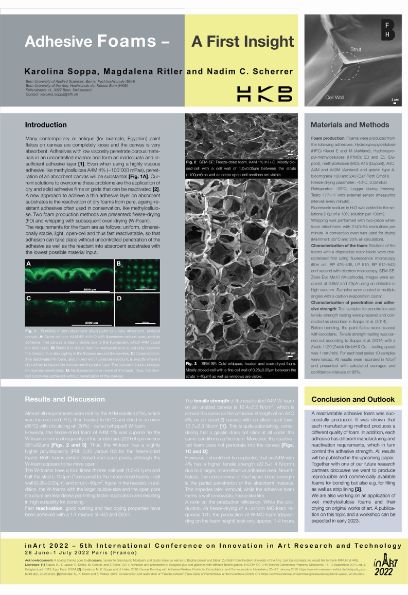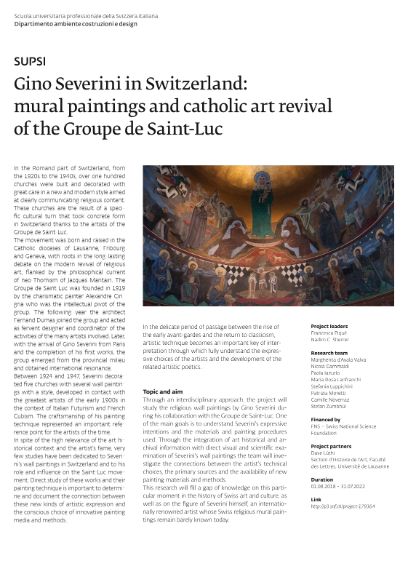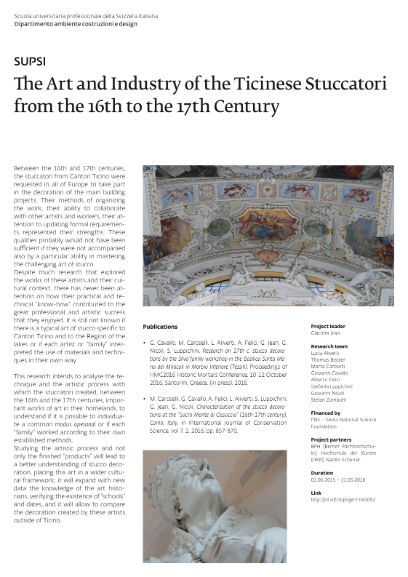2023
Moretti, P., Zumbühl, S., Scherrer, N., Piqué, F. (2023). Traditional and modern pigments in Gino Severini's Swiss murals Color Research & Application, pp. 1-20. Wiley-Blackwell 10.1002/col.22870
2022
Müller, L., Henniges, U., Schultz, J., Wöllner, A., Zumbühl, S., Brückle, I. (2022). Pressure-sensitive Tape Removal in Paper Conservation: A Review Journal of Paper Conservation, 23(2), pp. 59-75. Taylor & Francis 10.1080/18680860.2022.2060000
Konietzny, M., Dudew, E., Haller, U., Scherrer, N., Soppa, K. (2022). Klebstoffgitter aus Methylcellulosen für die Konservierung textiler Bildträger: Anwendungseigenschaften und Kennwerte im Vergleich zu Verklebungen mit BEVA® 371-Filmen ZKK - Zeitschrift für Kunsttechnologie und Konservierung(1), pp. 180-194. Wernersche Verlagsgesellschaft
Groetsch, A., Stelzl, S., Nagel, Y., Kochetkova, T., Scherrer, N., Ovsianikov, A., Michler, J., Pethö, L., Siqueira, G., Nyström, G., Schwiedrzik, J. (2022). Microscale 3D Printing and Tuning of Cellulose Nanocrystals Reinforced Polymer Nanocomposites Small, 19(3), p. 2202470. Wiley-VCH10.1002/smll.202202470
2021
Zumbühl, S., Zindel, C., Soulier, B. (2021). Varnish Technology during the 16th–18th Century: The Use of Pumice and Bone ash as Solid Driers Journal of Cultural Heritage, 47(47), pp. 59-68. Elsevier 10.1016/j.culher.2020.10.001
Moretti, P., Zumbühl, S., Caruso, O., Gammaldi, N., Iazurlo, P., Piqué, F. (2021). The Characterization of the Materials Used by Gino Severini in His 20th C Wall Paintings at Semsales in Switzerland, Applied Sciences Applied Sciences https://doi.org/10.3390/app11199161
Hofmann, C., Schaefer, I., Zumbühl, S., Ferreira, E. (2021). Einblick zur Farbveränderung in Laubdarstellungen, Kunsttechnologische Untersuchungen an zwei flämischen Landschaftsgemälden des 17.Jahrhunderts Zeitschrift für Kunsttechnologie und Konservierung
Hélou-de La Grandière, P., Boon, J.J., Scherrer, N., Zumbühl, S. (2021). Soulages’ Peinture 12 March 1960: diagnostic analytical studies and tentative consolidation of major curled-up delamination areas. Meddelelser om Konservering, 1, pp. 65-79. Nordiska Konservator Foerbundet, Nordisk Konservator Forbund. https://doi.org/10.24451/arbor.16444
Haudenschild, M., Soppa, K., Zumbühl, S., Scherrer, N., Becker, T., Wyer, P. (2021). Von Weiss zu Schwarz – Der Inkarnatfarbenwechsel der Einsiedler Madonna und ausgewählter Kopien. Zeitschrift für Kunsttechnologie und Konservierung, 34(2021/1), pp. 197-205. Wernersche Verlagsgesellschaft Worms
Scherrer, N., Kocsis, M., Dariz, P., Gervais, C. (2021). Sequential SEM imaging of microbial calcite precipitation consolidation treatment The European Physical Journal Plus, 136(5), pp. 1-10. Springer 10.1140/epjp/s13360-021-01497-7
Hendriks, L.S., Hajdas, I., Scherrer, N., Zumbühl, S., Stenger, J., Welte, C., Synal, H.-A., Günther, D. (2021). Advances and limitations of 14C dating in the field of heritage sciences Technè(52), pp. 111-117. Centre de recherche et de restauration des musées de France 10.4000/techne.10278
2020
Plackett, B. (2020). New chemical analysis allows for less invasive dating of artwork. Carbon dating of lead white paint from canvas edges could help uncover forgeries Chemical & Engineering News, 98(22) American Chemical Society
Hendriks, L., Caseri, W., Ferreira, E.S.B., Scherrer, N., Zumbühl, S., Küffner, M., Hajdas, I., Wacker, L., Synal, H.-A., Günther, D. (2020). The Ins and Outs of 14 C Dating Lead White Paint for Artworks Application Analytical Chemistry, 92(11), pp. 7674-7682. ACS American Chemical Society 10.1021/acs.analchem.0c00530
Caroselli M., Zumbühl S., Cavallo G. & Radelet T. (2020). Composition and techniques of the Ticinese stucco decorations from the 16th to the 17th century: results from the analysis of the materials. Heritage Science 8:102. https://doi.org/10.1186/s40494-020-00446-4
2019
Hendriks, L., Hajdas, I., Ferreira, E.S..B., Scherrer, N., Zumbühl, S., Küffner, M., Carlyle, L., Synal, H.-A., Günther, D. (2019). SELECTIVE DATING OF PAINT COMPONENTS: RADIOCARBON DATING OF LEAD WHITE PIGMENT Radiocarbon, 61(2), pp. 473-493. Cambridge University Press 10.1017/rdc.2018.101
Hendriks, L., Hajdas, I., Ferreira, E.S..B., Scherrer, N., Zumbühl, S., Smith, G.D., Welte, C., Wacker, L., Synal, H.-A., Günther, D. (2019). Uncovering modern paint forgeries by radiocarbon dating Proceedings of the National Academy of Sciences of the United States of America, 116(27), pp. 13210-13214. National Academy of Sciences (NAS) 10.1073/pnas.1901540116
2018
Cato, E., Rossi, A., Scherrer, N.C. and Ferreira, E.S.B. (2018). «An XPS study into sulphur speciation in blue and green ultramarine.» Journal of Cultural Heritage 29: 30-35. DOI:10.1016/j.culher.2017.09.005
Hendriks, L., Hajdas, I., Ferreira, E.S.B., Scherrer, N.C., Zumbuehl, S., Küffner, M., Wacker, L., Synal, H.-A. and Günther, D. (2018). «Combined 14C analysis of canvas and organic binder for dating a painting.» Radiocarbon 60(1): 207-218. DOI:10.1017/RDC.2017.107
2017
Cato, E., Scherrer, N. and Ferreira, E.S.B. (2017). «Raman mapping of the S3- chromophore in degraded ultramarine blue paints.» Journal of Raman Spectroscopy 48(12): 1789-1798. DOI: 10.1002/jrs.5256
Zumbühl, S., Hochuli, A., Soulier, B. and Scherrer N.C. (2017). Fluorination technique to identify the type of resin in aged vanishes and lacquers using infrared spectroscopy. Microchemical Journal 134, 317-326. https://doi.org/10.1016/j.microc.2017.06.013
Zumbühl, S., Brändle, A., Hochuli, A., Scherrer, N.C. and Caseri, W. (2017). Derivatization Technique To Identify Specifically Carbonyl Groups by Infrared Spectroscopy: Characterization of Photooxidative Aging Products in Terpenes and Terpeneous Resins. Analytical Chemistry 89(3): 1742-1748. DOI:10.1021/acs.analchem.6b04008
2016
Dietemann P., Neugebauer W., Baumer U., Fiedler I., Beil C., Obermeier A., Schäfer S., Zumbühl S., (2016). Analysis of Complex Binding Media Combining Chromatographic Techniques, Fluorescent Staining for Proteins and FTIR-FPA Imaging. In: Painting in Tempera, c. 1900, KUNSTmaterial 4, Beltinger K., Nadolny J. (Eds.), Schweizerisches Institut für Kunstwissenschaft SIK-ISEA Zürich, Archetype Publications, Zürich: 183-203.
Ferreira S.B., Wyss K., de Villemereuil V., Beltinger K., Marone F., Scherrer N.C. and Zumbühl S. (2016). The role of reconstructions in the identification of a wax/resin/gum tempera binder developed by Hermann Urban in 1901 and used by Cuno Amiet in 1902. In: Painting in Tempera, c. 1900, KUNSTmaterial 4, Beltinger K., Nadolny J. (Eds.), Schweizerisches Institut für Kunstwissenschaft SIK-ISEA Zürich, Archetype Publications, Zürich: 205-227.
Hendriks L., Hajdas I., McIntyre C., Küffner M., Scherrer N.C. and Ferreira E.S.B. (2016). Microscale radiocarbon dating of paintings. Applied Physics A 122:167. https://doi.org/10.1007/s00339-016-9593-x
2015
Engel N.L. and Zumbühl S. (2015). An evaluation of selected retouching media for acrylic emulsion paint. Journal of the American Institute for Conservation 54(4): 224-237.
Gervais C., Languille M.A., Moretti G., Reguer S. (2015): X-ray photochemistry of Prussian blue cellulosic materials: evidence for a substrate-mediated redox process. Langmuir 31: 8168
Ferreira E., Gros D., Wyss K., Scherrer N., Zumbühl S. and Marone F. (2015). Faded shine…. The degradation of brass powder in two nineteenth century paintings. Heritage Science 3(1): 1-11. https://doi.org/10.1186/s40494-015-0052-3
2014
Gervais C., Languille M.A., Reguer S., Garnier C. and Gillet M. (2014): Light and anoxia fading of Prussian blue dyed textiles. Heritage Science 2: 26.
Zumbuehl S., Scherrer N.C. and Eggenberger U. (2014). Derivatization technique to increase the spectral selectivity of two-dimensional Fourier transform infrared focal plane array imaging: Analysis of binder composition in aged oil and tempera paint. Applied Spectroscopy 68(4): 458-465. https://doi.org/10.1366/13-07280
Zumbühl S. (2014). Parametrization of the solvent action on modern artists’ paint systems. Studies in Conservation 59(1) 24-37.
https://doi.org/10.1179/2047058413Y.0000000099
Zumbuehl S., Scherrer N.C. and Mueller W. (2014). Derivatisation technique for infrared spectroscopy – characterisation of oxidative ageing products in modern oil paints. In Issues in contemporary oil paint. K. J. Van den Berg, A. Burnstock, M. de Keijzer et al., Springer Verlag: 213-225.
Franken V., Heydenreich G., Jägers E., Müller W., Schulz J. and Zumbühl S. (2014). Set Back the Race: Treatment Strategies for Running Oil Paint. In Issues in contemporary oil paint. K. J. Van den Berg, A. Burnstock, M. de Keijzer et al., Springer Verlag: 333-349.
Blumenroth D., Zumbuehl S., Scherrer N.C. and Mueller W. (2014). Sensitivity of modern oil paints to solvents: effects on synthetic organic pigments. In Issues in contemporary oil paint. Van den Berg K.J., Burnstock A., de Keijzer M. et al., Springer Verlag: 351-362.
Zumbuehl S., Scherrer N.C., Engel N.L. and Mueller W. (2014). The kinetics of dissolution of varnishes: The influence of vapour pressure on the rate of solvent action. ICOM-CC 17th Triennial Conference, Melbourne, International Council of Museums.
2013
Gervais C., Languille M.A., Reguer S., Gillet M., Pelletier S., Garnier C., Vicenzi E.P. and Bertrand L. (2013): Why does Prussian blue fade? Understanding the role(s) of the substrate. Journal of Analytical Atomic Spectrometry 28: 1600-1609.
Becker T. (2013). Die Kunst der Durchstrahlung von Kunst und Kulturgut. Schweisstechnik/Soudure, Offizielles Organ des Schweizerischen Vereins für Schweisstechnik, Ausgabe 01/2013: 17-20.
Blumenroth D., Zumbuehl S., Scherrer N.C. and Mueller W. (2013). Lösemittelsensitivität moderner Ölfarben - Empfindlichkeit synthetisch-organischer Pigmente in Künstlerfarben des 20. Jahrhunderts. Zeitschrift für Kunsttechnologie und Konservierung 27(1): 127-135.
2012
Wörle M, Hubert V., Hildbrand E., Hunger K., Lehmann E., Mayer I., Petrak G., Pracher M., von Arx U. and Wülfert S. (2012). Evaluation of decontamination methods of pesticide contaminated wooden objects in museum collections: Efficiency of the treatments and influence on the wooden structure. Journal of Cultural Heritage 13 (3) Supplement 209-215.
Becker T. (2012). Radiografie von Kunst und Kulturgut. ZfP-Zeitung, Zeitschrift der DACH-Gesellschaften DGZfP, ÖGfZP und SGZP, ISSN 1616-069X, Ausgabe 128: 50-52.
Scherrer N.C. and Zumbuehl S. (2012). Naturwissenschaftliche Ergebnisse. In Degradation an Hinterglasmalerei - vergleichende materialtechnologische Untersuchungen und Klassifizierung der Schadensbilder an Hinterglasgemälden des 18. Jahrhunderts. Bigler J. Bern, Hochschule der Künste Bern: 65-69.
Soulier B., Zumbuehl S., Echard J.-P., Scherrer N.C. and Wyss K. (2012). Resonanzen vergessener Oberflächen: Lautenfirnisse der Renaissance Teil 2. Zeitschrift für Kunsttechnologie und Konservierung 26(2): 462-471.
2011
Becker T. (2011). Verborgenes Entdecken, Artikel über die Radiografie von Kunst und Kulturgut in: Nike-Bulletin 1-2: 24-27.
Zumbuehl S., Scherrer N.C., Ferreira E.S.B., Hons S., Mueller M., Kuehnen R. and Navi P. (2011). Accelerated ageing of drying oil paint: an FTIR study on the chemical alteration: problems of accelerated ageing under variable conditions of light, temperature and relative humidity. Zeitschrift für Kunsttechnologie und Konservierung 25(2): 339-351.
2010
Zumbuehl S., Ferreira E.S.B., Scherrer N.C. and Schaible V. (2010). The non-ideal action of binary solvent mixtures on oil and alkyd paint, Cleaning 2010 – New Insights into the Cleaning of Paintings, Preprints containing the abstracts of the international conference, Valencia 26.-28. May 2010, L. Fuster-Lopez, E.A. Charola, M.F. Mecklenburg, M.T. Domenénech-Carbo (Eds.), Universidad Polytecnica de Valencia and Smithonian Institute, Valencia (2010) 43-44. https://doi.org/10.5479/si.19492359.3.1
Zumbuehl S. and Scherrer N.C. (2010). Die Auswirkungen der morphologischen Strukturveränderungen auf die Materialeigenschaften von Dispersionsfarben. Zeitschrift für Kunsttechnologie und Konservierung 24(1): 76-87.
2009
Ferreira E.S.B., Boon J.J., van der Horst J., Scherrer N.C., Marone F. and Stampanoni M. (2009). 3D Synchrotron x-ray microtomography of paint samples. Proceedings SPIE 7391(Optics for Arts, Architecture, and Archaeology II, Munich, 15 July 2009): 73910L73911-73918.
Scherrer N.C., Zumbuehl S., Delavy F., Fritsch A. and Kuehnen R. (2009). Synthetic organic pigments of the 20th and 21st century relevant to artist's paints: Raman spectra reference collection. Spectrochimica Acta Part a-Molecular and Biomolecular Spectroscopy 73(3): 505-524. https://doi.org/10.1016/j.saa.2008.11.029
Zumbuehl S., Scherrer N.C., Berger A. and Eggenberger U. (2009). Early Viridian pigment composition characterization of a (hydrated) chromium oxide borate pigment. Studies in Conservation 54(3): 149-159. https://www.jstor.org/stable/27867083
Käser F. and Bohn M. (2009). Decomposition in HTPB bonded HMX followed by heat generation rate and chemiluminescence. Journal of thermal Analysis and Calorimetry 96 (3) 687-695.
Zumbühl S., Gross M. (2009). Alexej von Jawlensky, Wassily Kandinsky – Eine Künstlerfreundschaft aus materialtechnologischer Sicht. Reihe Bild und Wissenschaft – Forschungsbeiträge zu Leben und Werk Alexej von Jawlenskys, Band 3, Alexej von Jawlensky Archiv Locarno 256-263.
Zumbühl S., Segieth-Wuelfert F., Wuelfert S. (2009). Die Spitze des Eisbergs... – Kunsttechnologie und Fälschungsproblematik. Reihe Bild und Wissenschaft – Forschungsbeiträge zu Leben und Werk Alexej von Jawlenskys, Band 3, Alexej von Jawlensky Archiv Locarno 252-255.
2008
Comiotto A. (2008). Miniaturized cold atmospheric plasma for the conservation of plastics in modern and contemporary art. Chimia 62 (11) 877-881.
Käser F. and Roduit B. (2008). Lifetime prediction of rubber using the chemiluminescence approach and isoconversional kinetics. Chimia 62 (11) 908-912.
Buder A. (2008). Dammar resin degradation revisited. Chimia 62 (11) 913-917.
Käser F. and Roduit B. (2008). Prediction of the ageing of rubber using the chemiluminescence approach and isoconversional kinetics. Journal of Thermal Analysis and Calorimetry 93 (1) 231-237.
Zumbuehl S., Attanasio F., Scherrer N.C., Mueller W., Fenners N. and Caseri W. (2008). Solvent action on dispersion paint systems and the influence on the morphology-changes and destruction of the latex microstructure. Postprints of the Symposium; Modern Paint Uncovered, Tate Modern London, Tom Learner (Ed.), 17-19. May 2006, Tate Modern 255-266.
Zumbühl S. (2008). Material choice in the context of the artistic working phase – the use of synthetic organic colorants by Alexej von Jawlensky (1864-1941), Preprints, Scientific Workshop at the Doerner Institute München, Germany: „Permanent Yellow, Irgazine Red, Heliogen Blue and Co.: Towards an Improved Micro-identification of Synthetic Organic Pigments and Dyestuffs in Works of Modern Art“, 12. Sept. (2008).
Fuesers O., Zumbühl S. (2008). The Influence of Organic Solvents on the Mechanical Properties of Alkyd and Oil Paint, NDT Database & The e-Journal of Nondestructive Testing, Conference Proceeding, ART2008 – 9th International Conference, May 25-30 2008, Jerusalem, www.ndt.net, 219Fuesers.pdf, 1-14.
Kilchhofer M. and Scherrer N.C. (2008). Konservierung von Malereien auf Lehmputzen. Zeitschrift für Kunsttechnologie und Konservierung 22(2): 343-354.
2007
Segieth-Wuelfert F., Wuelfert S. und Zumbuehl S. (2007). Der Teufel steckt im Detail – Der Beitrag der Kunsttechnologie bei der Weiterführung des Catalogue Raisonné Alexej von Jawlensky. Zeitschrift für Kunsttechnologie und Konservierung 21(2): 330-335.
2006
Fuesers O. and Zumbuehl S. (2006). Vorsicht bei der Beleuchtung! Die spezifische Empfindlichkeit von Spätwerken Alexej von Jawlenskys – Untersuchungen zu maltechnisch bedingten Strukturveränderungen. Reihe Bild und Wissenschaft, Forschungsbeiträge zu Leben und Werk Alexej von Jawlenskys, Band 2, 103-110.
<2005
Zumbuehl S. and Scherrer N.C. (2003). Aktive Passivierung der Degradation cellulotischer Strukturgefüge. Zeitschrift für Kunsttechnologie und Konservierung 17(1): 387-396.
Dietemann P., Kälin M., Zumbühl S., Knochenmuss R., Wülfert S. and Zenobi R. (2001). A mass spectrometry and electron paramagnetic resonance study of photochemical and thermal aging of triterpenoid varnishes. Analytical Chemistry 73(9) 2087-96.
Dietemann P., Meisterhans C., Pfeiffer C., Zumbühl S., Knochenmuss R. and Zenobi R. (2000). Artificial Photoaging of Triterpenes Studied by Graphite-Assisted Laser Desorption/Ionization Mass Spectrometry. Helvetica Chimica Acta 83(8) 1766-1777.
Zumbühl S. and Wuelfert S. (2001). Chemical Aspects of the Bookkeeper Deacidification of Cellulosic Materials: The Influence of Surfactants. Studies in Conservation 46(3) 169-180.
